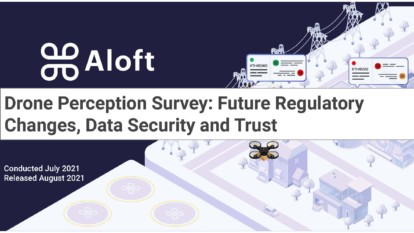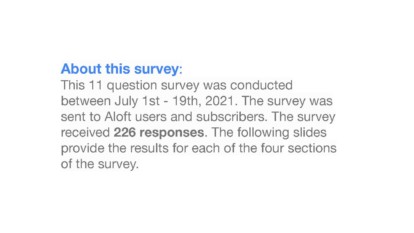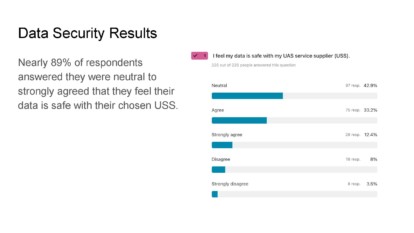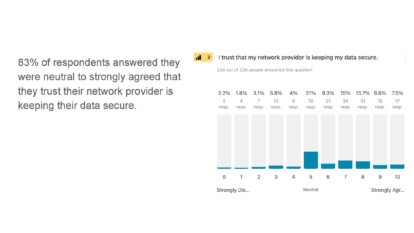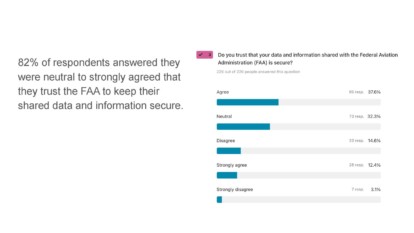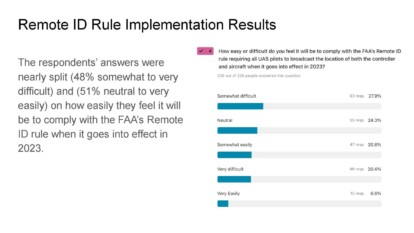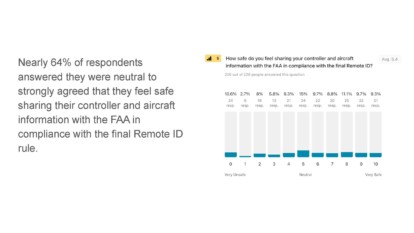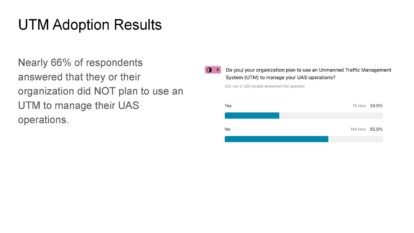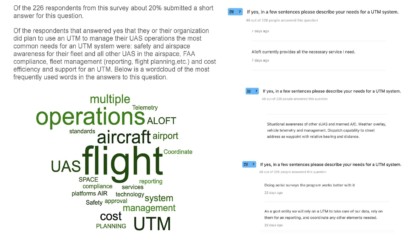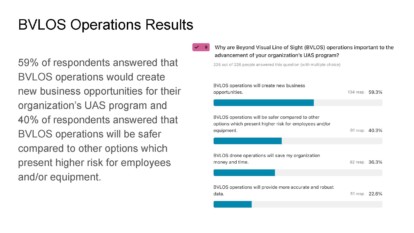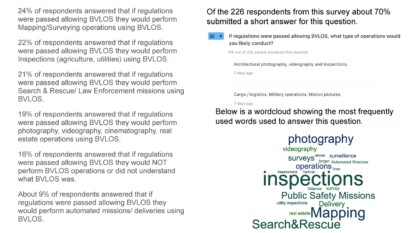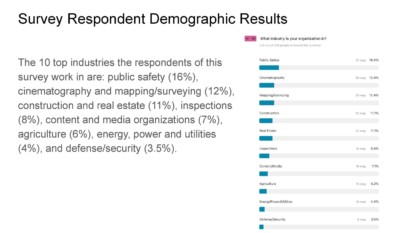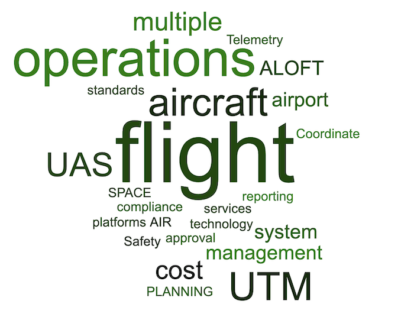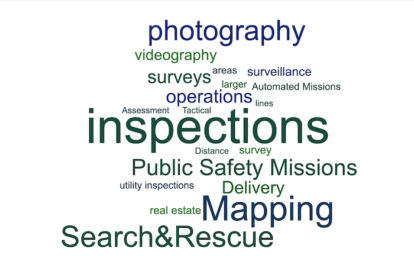How safe is my data? A user study on data security and potential use cases enabled by regulatory changes
Aloft is proud to work with many key stakeholders across the drone industry. Our principles for public policy are all essentially about the same thing: enabling flight at scale with safety and compliance. We recently joined the Board of the Commercial Drone Alliance (CDA) and were named a member of the FAA’s new Beyond Visual Line-of-Sight (BVLOS) Aviation Rulemaking Committee. We’re excited to bring the voice of our enterprise customers and represent the largest user base of recreational drone pilots in these efforts.
To further our mission and bring new insights into future industry discussions, we recently conducted a study of our community to gain insight on how drone pilots and operators feel about future regulatory changes and the impact they could have on future drone use cases and operations. This 11 question survey was conducted between July 1st – 19th, 2021. The survey was sent to Aloft users and subscribers and received 226 responses from a variety of industry users. View a slide show of the results for each of the four sections of the survey below. Keep reading for the collected data and analysis of the study on topics including drone data security, remote ID implementation, UTM adoption, and BVLOS operations.
Data Security
Data security and general information safety is paramount for the continued success and growth of the drone industry. For this reason, we are constantly working to improve and strengthen our platforms’ security and interested in what type of security improvements our user’s need for their drone programs. In this study, respondents were asked how safe they felt their data was with their chosen UAS Service Supplier (USS), network provider, and with the FAA. Nearly 89% of respondents answered they were neutral to strongly agreed that they feel their data is safe with their chosen USS. 83% of respondents answered they were neutral to strongly agreed that they trust their network provider is keeping their data secure. 82% of respondents answered they were neutral to strongly agreed that they trust the FAA to keep their shared data and information secure. In looking at these results, we see that the majority of users feel their network provider (i.e. cellular service provider), USS and the FAA are keeping their data and personal information secure.
Remote ID Implementation
The second section of the survey asked respondents their opinion on future implementation of remote identification for UASs. The respondents’ answers were nearly split (48% somewhat to very difficult) and (51% neutral to very easily) on how easily they feel it will be to comply with the FAA’s Remote ID rule when it goes into effect in 2023. Nearly 64% of respondents answered they were neutral to strongly agreed that they feel safe sharing their controller and aircraft information with the FAA in compliance with the final Remote ID rule. While the majority of respondents felt that the personal information required to be shared with the FAA in compliance with Remote ID will be safe, the respondents were nearly split on how easy they felt the implementation of Remote ID would be. As we edge closer to the Remote ID rule’s effective date in 2023, we hope operators will gain further clarity on how UTM solutions like our Air Control platform can streamline airspace awareness and provide the necessary tools for Remote ID compliance for all operators in enterprise drone programs.
UTM Adoption
The final section of the survey asked respondents their opinion on the adoption of UTM. Nearly 66% of respondents answered that they or their organization did NOT plan to use an UTM to manage their UAS operations. Of the 226 respondents from this survey, about 20% submitted a short answer describing their UTM needs.
Of the respondents that answered that they or their organization did plan to use an UTM to manage their UAS operations, the most common needs for an UTM system were: safety and airspace awareness for their fleet and all other UAS in the airspace, FAA compliance, fleet management (reporting, flight planning,etc.) and cost efficiency and support for an UTM. In the wordcloud below you will see the most frequently used words in the answers to this question.
From these results, we can glean that users are looking to UTM to provide FAA compliance, fleet management and airspace awareness from one cost efficient platform.
BVLOS Operations
As many of you may agree, future regulatory changes enabling beyond visual line of sight (BVLOS) operations could greatly expand the capabilities of drone operations in the US. 59% of respondents answered that BVLOS operations would create new business opportunities for their organization’s UAS program and 40% of respondents answered that BVLOS operations will be safer compared to other options which present higher risk for employees and/or equipment.
Of the 226 respondents from this survey about 70% submitted a short answer for the type of BVLOS operations they would likely conduct if future regulations allowed it.
24% of respondents answered that if regulations were passed allowing BVLOS they would perform Mapping/Surveying operations using BVLOS.
22% of respondents answered that if regulations were passed allowing BVLOS they would perform Inspections (agriculture, utilities) using BVLOS.
21% of respondents answered that if regulations were passed allowing BVLOS they would perform Search & Rescue/ Law Enforcement missions using BVLOS.
19% of respondents answered that if regulations were passed allowing BVLOS they would perform photography, videography, cinematography, real estate operations using BVLOS.
About 9% of respondents answered that if regulations were passed allowing BVLOS they would perform automated missions/ deliveries using BVLOS.
While 16% of respondents answered that if regulations were passed allowing BVLOS they would NOT perform BVLOS operations as it was not critical or impactful to their current operations.
In the wordcloud below you will see the most frequently used words in the answers to this question.
From these survey questions on BVLOS, we can conclude that users feel there are many use cases which are currently not possible for drones but with BVLOS regulatory changes could enable opportunity for drones to be used in new and innovative ways. Though to note, 16% of respondents stated they would not perform BVLOS operations even if regulatory changes permitted it. This study shows that inspections, mapping, search & rescue and photography were among the most frequently listed types of operations users would like to use BVLOS for.
As drone technology continues to evolve with more automation in hardware and software, the regulatory framework will need to change to meet these new capabilities and continue propelling the drone industry forward. Above innovation though, security and safety will always remain the cornerstones of aviation culture. Remote ID regulations and the adoption of UTM for enterprise drone programs will ensure that the future of the drone industry continues to evolve with data security and operational safety as the guiding forces. The implementation of Remote ID in 2023 for all UAS operators and the adoption of UTM systems by enterprises will provide greater airspace visibility and safety while also keeping each user’s data and personal information secure. The potential for future use cases to be enabled with BVLOS regulations is something that the users in this study confirmed is highly important for the advancement of the industry. The response from this study is clear, drone users are looking to regulators to continue evolving the industry’s regulatory infrastructure to support innovation and expand the possibilities for drone use cases in the future.
Jon Hegranes - Aloft CEO
Jon is the Founder & CEO of Aloft, the market leader in drone airspace systems & UTM technologies. Aloft’s patented technology is used in today’s leading recreational, enterprise, and government drone applications.
Jon is a certified commercial drone pilot as part of FAA Part 107, the founder of the Drone Advisory Council, and is an active member of other industry groups, including GUTMA, NBAA Emerging Tech, the FAA’s Advanced Aviation Advisory Committee (AAAC) and working groups, and is a founding member and data working group chair of the FAA Drone Safety Team. He’s a self-taught iOS developer, writes about drone topics for technology news outlets including VentureBeat, TechCrunch, and Forbes, and regularly speaks at industry events such as Commercial UAV Expo, 2B Ahead Future Congress, and DJI AirWorks. Jon graduated from TCU with a major in finance and received his MBA from Thunderbird Global School of Management (ASU). Jon has served on multiple FAA Advisory and Rulemaking Committees (ARCs), including drone detection, counter UAS, and Beyond Visual Line of Site (BVLOS).
